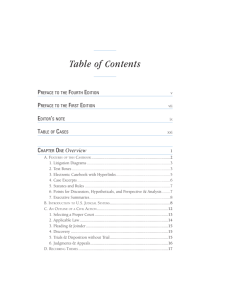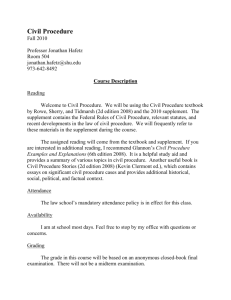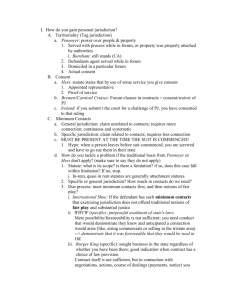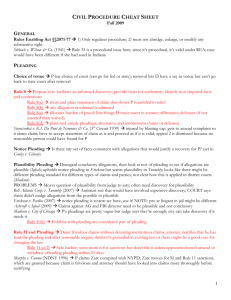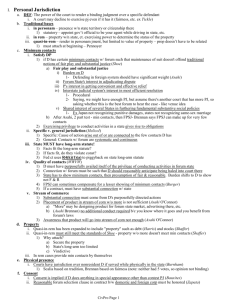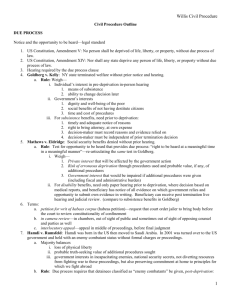CivPro_Rubenstein_F2010 – Outline (H)
advertisement
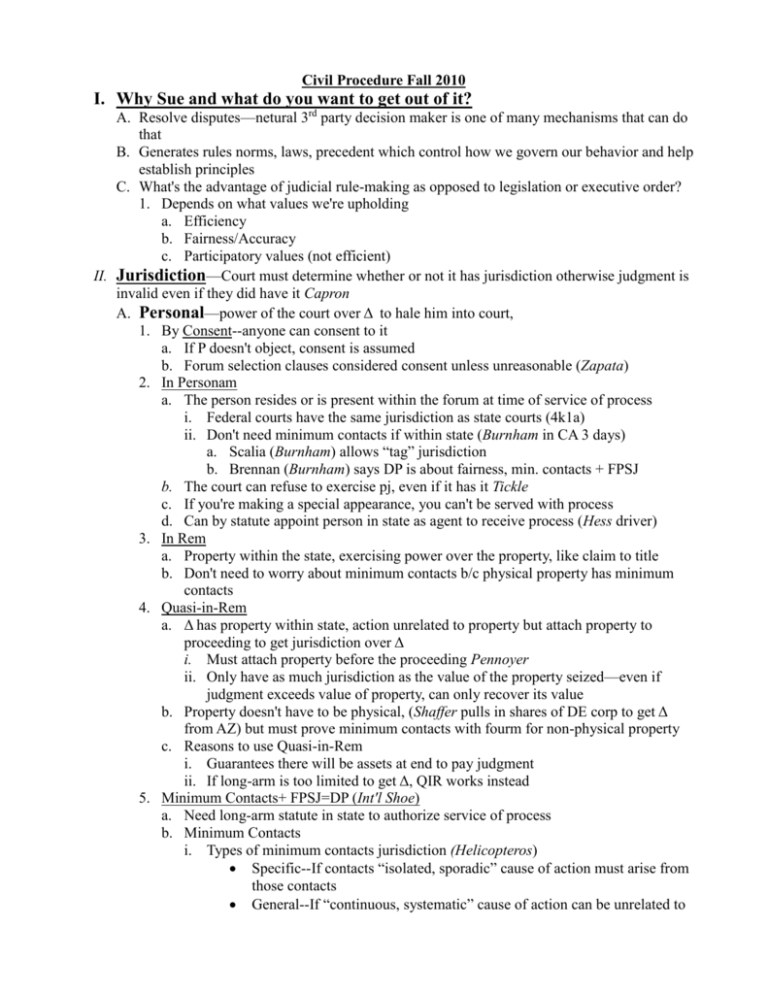
Civil Procedure Fall 2010 I. Why Sue and what do you want to get out of it? A. Resolve disputes—netural 3rd party decision maker is one of many mechanisms that can do that B. Generates rules norms, laws, precedent which control how we govern our behavior and help establish principles C. What's the advantage of judicial rule-making as opposed to legislation or executive order? 1. Depends on what values we're upholding a. Efficiency b. Fairness/Accuracy c. Participatory values (not efficient) II. Jurisdiction—Court must determine whether or not it has jurisdiction otherwise judgment is invalid even if they did have it Capron A. Personal—power of the court over Δ to hale him into court, 1. By Consent--anyone can consent to it a. If P doesn't object, consent is assumed b. Forum selection clauses considered consent unless unreasonable (Zapata) 2. In Personam a. The person resides or is present within the forum at time of service of process i. Federal courts have the same jurisdiction as state courts (4k1a) ii. Don't need minimum contacts if within state (Burnham in CA 3 days) a. Scalia (Burnham) allows “tag” jurisdiction b. Brennan (Burnham) says DP is about fairness, min. contacts + FPSJ b. The court can refuse to exercise pj, even if it has it Tickle c. If you're making a special appearance, you can't be served with process d. Can by statute appoint person in state as agent to receive process (Hess driver) 3. In Rem a. Property within the state, exercising power over the property, like claim to title b. Don't need to worry about minimum contacts b/c physical property has minimum contacts 4. Quasi-in-Rem a. Δ has property within state, action unrelated to property but attach property to proceeding to get jurisdiction over Δ i. Must attach property before the proceeding Pennoyer ii. Only have as much jurisdiction as the value of the property seized—even if judgment exceeds value of property, can only recover its value b. Property doesn't have to be physical, (Shaffer pulls in shares of DE corp to get Δ from AZ) but must prove minimum contacts with fourm for non-physical property c. Reasons to use Quasi-in-Rem i. Guarantees there will be assets at end to pay judgment ii. If long-arm is too limited to get Δ, QIR works instead 5. Minimum Contacts+ FPSJ=DP (Int'l Shoe) a. Need long-arm statute in state to authorize service of process b. Minimum Contacts i. Types of minimum contacts jurisdiction (Helicopteros) Specific--If contacts “isolated, sporadic” cause of action must arise from those contacts General--If “continuous, systematic” cause of action can be unrelated to contacts ii. Quality of Contacts (WW Volkswagen) a. Δ must “purposefully avail” himself of the forum Foreseeability is not enough b. Such that Δ can reasonably anticipate being haled into court c. Fair Play and Substantial Justice—5 factor test (Burger King) could possibly make up for weak contacts (Brennan's idea) i. Burden on Δ ii. P's interest in convenient and effective relief iii. Forum's interests in the case iv. Efficienct resolution in state controversies a. Is there another state that is a better forum? v. Substantive social policies in the forum d. Stream of Commerce i. Manufacturer responsible for where something ends on supply chain (Gray valve) but not where buyer takes it (WW Volkswagen car) ii. O'Connor says stream of commerce not enough, must also purposefully avail a. e.g. design for forum, advertise there, have agent, etc. (Asahi) iii. Brennan says stream of commerce enough if aware product is marketed in forum (Asahi) B. Subject Matter—Power of the court to hear the case at hand 1. State Courts can hear anything, they are courts of general jurisdiction 2. Article III establishes available smj for federal courts, but congress in USC 28 determines how much of it they can actually use a. Statutes are the basis for federal smj b. Federal courts are courts of limited jurisdiction c. Federal SMJ can be raised at any time during the case 3. Diversity Jurisdiction 28 USC 1332 a. Diversity of Citizenship—on opposite sides of the V i. In general, need complete diversity (no same state on either side of V) ii. Some statutes allow smj when there is minimum diversity iii. Individual citizenship for purposes of SMJ is domicile (Mas) a. Where you live b. With intent to stay (factual inquiry) If not currently domiciled, go back to most recent place you were domiciled Can be domiciled if you don't have specific plans to leave and just have general idea you'll leave at some time iv. Corporate Citizenship a. Place of incorporation b. Principal place of business v. Associations and Partnerships a. Every state where any member is a citizen b. Amount in Controversy > $75,000 i. Amount must be alleged by P and is taken to be true unless Δ can show to a legal certainty that P can't recover more than 75K ii. For injunctions and declaratory judgments look at value of judgment iii. Aggregation a. 1 P can aggregate all her claims against 1 Δ to reach 75K b. Multiple Ps cannot join claims against Δ to reach 75K c. Can use joinder rules if 1 P has claim over 75K and other P's COAs are from same transaction and occurrence 4. Federal Question 28 USC 1331 a. “Well-Pleaded Complaint”--Federal Question must be part of COA can't be response to Δ's possible defense (Mottley railroad pass denied b/c breach of contract, constitutional claim response to Δ's defense, Harms case about song's licenses, not its copyright) b. Test for Federal Question Grable i. Claim necessarily raises federal issue ii. The federal issue is actually disputed and substantial iii. Will federal court's hearing change balance between federal and state responsibilities? c. For some issues, consistency is so important that they are the exclusive jurisdiction of federal courts d. Types of Federal Question cases i. Easy Cases a. Arises under actual federal law like constitution (Pruitt, Fuentes) b. Federal Statute dictates federal question (Civil Rights Act) ii. US government is a party (Osborn) iii. Case looks like it has federal issue but doesn't arise under federal law (Harms) iv. State case that turns out to have a federal question (Merrell Dow FDCA doesn't have private right of action, so it's actually a federal question case b/c state court can't interpret FDCA) 5. Removal 28 USC 1441 a. Δ can remove case to federal court if it could have originally been brought there b. If Δ is in-state cannot remove a diversity case c. Federal Question cases can always be removed 6. Supplemental Jurisdiction 28 USC 1367 a. If you already have smj over one part of the claim you can “hook” on something you wouldn't normally have smj over b. Cases leading up to 1367 i. “Case” test (Gibbs) if federal and state claims arise out of the same “case” (common nucleus of fact) can be heard in federal court ii. Can't add new party with new claim if not allowed under federal law. (Aldinger tries to add county to Civil rights claim that doesn't apply to local gov't) iii. Adding new party can't circumvent complete diversity requirement (Kroger, turns out 2nd Δ was from same state as P) iv. Supplemental jurisdiction must be specifically authorized by statute (Finley although claim has exclusive federal jurisdiction b/c suing US, not allowed to “hook” on state claims for state and local gov't) c. 1367—Current Supplemental Jurisdiction Rule i. If “arises out of same case or controversy” then yes unless precluded by 1367(b) ii. 1367(a) if there are original federal claims, there is supplemental jurisdiction over any other claim arising from same case or controversy unless limited by (b) iii. 1367(b) In diversity cases, you can't have supplemental smj over parties if it destroys complete diversity iv. 1367 ( c) Court can chose to not to exercise jurisdiction a. Novel or complex issue of state law b. State claim predominates federal claim c. All federal claims have been dismissed d. Other compelling reasons d. Amount in Controversy—If same “case” and one P has satisfied amount in controversy, can bring in other Ps with lesser amounts as long as you don't destroy diversity (Exxon girl with .75K and parents with < 75K) C. Venue—convenience within the selected forum 28 USC 1391 and 1404 1. Venue is purely statutory 2. Venue is waived unless objected to in answer to complaint (12(b)(3) 3. There can be multiple districts with good cases for venue, only need to be in one of them 4. Venue puts logic back in the claim that any court anywhere can entertain a case 5. 1391 (a)--diversity case factors for venue a. Where Δ resides i. Goal to steer venue to judicial district where Δ resides b. Where events took place i. Consideration of witnesses, evidence, etc. c. Personal Jurisdiction, if no other place exists (hardly ever used) i. Don't use catchall unless no other options exist 6. 1391 (b)--federal question rules for venue a. Where Δ resides b. Where events took place c. Where found if no other place (same as (a)(3)) 7. 1391 ( c)--Corporate Defendants a. Reside anywhere they are subject to personal jurisdiction at commencement of action (can be more than 2 places, unlike PJ rule) b. If multiple districts in state, must have PJ within the district itself i. Bates Δ, debt collector, only has one contact in WDNY, but it's relevant to case 8. Residence for Venue Purposes a. Individuals—Rules of SMJ for diversity i. Domicile=reside with intent to stay b. Corporations i. Where subject to PJ c. Aliens i. Anywhere 9. Transfer of Venue a. 1404 to forum where could be originally brought (must have SMJ, PJ, and Venue Blaski) allowed, under judge's discretion, for: i. Convenience of parties ii. Convenience of witnesses iii. Interests of justice b. Change of Venue does not change choice of law rules, use choice of law of original venue 10. Forum Non Conveniens a. Point of FNC is not to say that court doesn't have jurisdiction, it's to say that jurisdiction is proper within another system (Piper, suit best in Scotland, can't transfer b/c out of system) i. In US, either with foreign party or intrastate (ex. MA-CA) b. Also look at Choice of law concerns (Piper, CA choice of law from original claim says PA law, PA claim for D2 says Scottish law) III. Ascertaining the Applicable Law A. Old standard—Swift v. Tyson interpreted Judiciary 1652 “laws of the several states” to say that federal courts applied the statutes of the state they were in but the “federal common law” instead of state common law B. Erie—overturns Swift to say that there is no “federal common law” and 1652 means both statues and common law of the state in which they sit Federal Courts Pre-Erie (1938) Post-Erie and FRCP Procedure State Rules of Civ. Procedure FRCP Substantive Law “Federal Common law” Swift State law Erie C. Problems with Swift and Erie 1. Both have uniformity problems a. Under Swift the same issue could have different outcomes depending on whether parties are from same state or diverse states (same injury just change D's state and change outcome) i. State case—state law ii. State law diversity case—federal law b. Under Erie it the same federal case case could have different outcomes depending on which state D is from (same injury D1 from X and D2 from Y) i. Case in D's state (x)—X's choice of law ii. Case in D's state (y)—Y's choice of law 2. Both have forum shopping problems a. When P picks forum, she's also picking the choice of law regime b/c that doesn't change with venue D. Choice of law rules—Klaxxon says apply the choice of law rules of the forum in which you sit 1. Choice of law rules from first venue stay with any transfer of venue IV. Procedural Due Process=Notice and Opportunity to be heard A. First step is actually determining Personal Jurisdiction since lack of it is a violation of DP B. Notice—Reasonableness standard (Mullane) 1. Must be reasonably calculated to reach Δ a. Must include required information b. Allow time for the party to make an appearance c. Prove an actual desire for the party to get notice 2. Exceptions when a published notice is sufficient a. If Δ is unknowable (E.g not yet born) b. If Δ is unknown (E.g., Alive but don't know where they live and didn't have reason to know) c. If made reasonable efforts to locate Δ , but can't (Dusenbery, in prison) (Jones mail returned b/c nobody there to sign, says could have done more by sending mail noncertified) C. Opportunity To be Heard 1. General idea is hearing at a meaningful time and in a meaningful manner (Goldberg) a. Need to be aware of power relationships i. People with fewer resources are in a more vulnerable position in an adversarial system b. Values behind OTBH i. Fairness ii. Dignity iii. Equality iv. Tradition 2. 3 factor test (Matthews) a. Government Interests (efficiency, administrative burden) b. Individual Interests in the property/right c. Risk of Error 3. When can we dismiss OTBH? a. When assets may be destroyed b. To get Quasi-In-Rem jurisdiction c. Cost outweighs Δ's interest (Matthews) 4. Cases a. Benefits—benefits terminated prior to hearing i. Goldberg—must have hearing for welfare benefits ii. Matthews—ok not to have hearing for disability benefits because of smaller impact on indiv. and risk of error b. Repossession—property taken before hearing i. Fuentes replevin prior to judgment without OTBH is unconstitutional b/c violates “meaningful time” standard ii. Mitchell sequestration ok b/c law provides for specified affidavit and early hearing when P must prove affidavit a. Possible overturning of Fuentes iii. DiChem garnishment statute overturned, requires affidavit with only allegations and double bond. c. Prejudgment Attachment i. Doehr statute that allows attachment of Δ's house pre-judgment and only requires P to show probable cause he'll win to attach property, overruled on Risk of Error part of Matthews test. V. Pleading A. Rule 8 Complaint =short and plain statement of facts showing you're entitled to relief 1. Must show grounds for SMJ 2. Must show claim and how P is entitled to relief 3. Demand for judgment B. Rule 12 Pleading resolves concerns we have about civil litigation 1. Rule 12(b) motions a. 1. No SMJ (can be brought at any time) b. 2. No PJ c. 3. Improper venue d. 4. Insufficiency of process e. 5. Insufficiency of service of process f. 6. Failure to state a claim upon which relief can be granted g. 7. failure to join a necessary party under FRCP 19 (can be brought at any time) 2. What must be in the complaint to survive a motion to dismiss? a. Also have to balance what you can fairly plead and still survive 12b6 and what you need to prove at trial to win i. Sometimes it's not good to have too much information if that info is speculative and you may not be able to prove exact fact at trial b. Don't have to have legal terms, just need enough to allow Δ to investigate and defend themselves (DioGuardi, P writes his own complaint about stolen items) c. Dismissed if P can prove no set of facts to support claim (Conley) d. Complaint must be plausible (Twombly allegations of antitrust must be above speculative level, into plausible before discovery will be allowed; Iqbal accusations about Atty Gen.) 3. Need to find balance between weeding out frivolous suits for efficiency without deterring meritorious ones 4. Responds to issues about jurisdiction 5. 12(b) 6=Δ can move to dismiss complaint for failure to state a claim upon which relief can be granted 6. Sorts out frivolous complaints and suits, at least those impossible (martians) or not possible (non-existent car accident) that are accompanied by an affidavit 7. Sorts out complaints we can't make sense of 8. When P pleads 1 case but actually has 2nd Judge may help out by finding cause (Pruitt, court finds equal protection claim and Case, insurance agent sues company for meddling) 9. Assesses quality of the legal cause, if its found insufficient it's dismissed a. If discovery won't help P b/c no set of facts would prove case (Conley) 10. Tries to prevent fishing for settlements (Twombly, Iqbal) C. Rule 11—Attorney's signature to complaint (technically all court filings) 1. 11.(a) Attorney must sign every document 2. 11(b) Attorney must “reasonably inquire” and certify “to the best of” his knowledge a. (1) No improper purpose b. (2) claims and defenses supported by existing law c. (3) evidentiary support for factual contentions (or will likely have after discovery) d. (4) denials of facts are based on evidence or belief or lack of information 3. 11(c) Sanctions for violation a. Sanctions can be to atty, firm, or party depending on who is responsible for them b. Other party can notify of Rule 11 motion, party has 21 days to withdraw c. Puts burden on attorney's to keep from filing frivolous suits 4. 11(d) Doesn't apply to discovery documents D. Answer 1. Δ's answer responds to each allegation in P's complaint, helps show what issues are in dispute 2. Δ can move to dismiss certain causes of action but not all 3. Δ must raise affirmative defenses in the answer or can't raise them at trial VI. Joinder A. When considering joinder rules, must consider jurisdictional requirements and preclusive effects of judgment 1. A lawsuit is structured as 1 P , 1 Δ, and 1 cause of action, anytime you have more than that, there must be a joinder device to allow it 2. Anytime you join something you must Jurisdiction over it a. Need SMJ for claims b. Need PJ for parties 3. Anytime you have joinder it will have an effect on future judgments (preclusion) 4. Policy reasons behind joinder a. Judicial Efficiency and economy b. Less expensive for P c. Inconsistent outcomes B. Joinder of Claims (must have PJ, SMJ, and Venue use supplemental jurisdiction as last resort if don't have diversity or federal ? remember 1367 (b) only applies to Ps) 1. Rule 18—All claims against a party can be joined into one action 2. Counter-claims (across the “v”) a. 13(a) Compulsory—arising from same transaction and occurrence (efficiency goal) i. Doesn't mean you have to bring claim, but if you don't you can't bring it later ii. Turns the “may join” from 18(a) into “must” b. 13(b) Permissive—any other claims against Δ c. P master of his own complaint, can split among systems (state and fed) if he wants but needs to think about preclusive effect of first Jment on 2nd (Temple v Synthes) 3. Cross-claims (same side of the “v”) a. 13(g) allowed when they arise from same “transaction or occurrence,” “may” usually can be brought in later suit because want P to be master of his complaint b. Hinge on whether you define “transaction or occurrence” broadly (LASA Majority says it's “marble at city hall” or narrowly LASA dissent says it's only “transactions b/w LASA and Alexander) The more you allow in, the more you preclude C. Joinder of Parties (must have PJ) 1. 20(a)2 allows joinder of parties (either P or D) if you have same transaction and same question of law or fact 2. 13(h) allows addition of parties consistent with 19 and 20 for counter and cross claims 3. 14—Impleader Δ can bring in 3rd party who is liable to him (indemnification) 4. 19—Necessary party, either party can claim 3rd party necessary either because 1) no complete relief in their absence or 2) have an interest and in their absence it will be a) impaired or impeded or b) create inconsistent obligations a. Not taken seriously b/c rule 24 allows parties to intervene, which lessens the need to drag people in under 19 Key difference is autonomy 5. 24—Intervention a. People who can intervene in 24 are similar to necessary parties in 19 b. Can be P (must look at smj to make sure she can intervene) c. or Δ (also need jurisdictional analysis) 6. 22—Interpleader—civil version of bankruptcy a. Δ puts a sum of money down and asks anyone with claims to come argue for it, precludes all separate suits for the money b. Pure Interpleader, Δ walks away after putting down money and Ps fight amongst themselves c. Action in nature of interpleader-- Δ puts down $ and has right to defend claims VII. Class Actions—Rule 23 A. 23(a) “Who” need all 1. Numerosity—joinder impractical 2. Commonality in law and fact among Ps 3. Typcality—representative must have claims typical of class 4. Adequacy—representative fairly and adequately represents interest of the class (Hansbury, black homebuyer not represented in prior class action about white homeowners covenant to sell) B. 23(b) “When” need 1 1. Limited Fund-Δ has limited amount of money without class action there will be discrimination on who gets the right amount of money 2. Injunctions—(civil rights cases classic example) decree in one case will affect all the others. Allows class to participate in case that will affect them. 3. Money Damages--(most class actions today) a. Large claims—hard to certify b. Small claims—core of whole idea, claim is too small for individual P to want to bring it joining together makes case economically viable. If gov't won't litigate, class action is the private solution c. Notice is required (unlike in 1 and 2) d. Common question of law or fact must predominate over individual issues e. Class action mechanism must be superior to other forms of litigation considering i. Members interest in personally controlling prosecution/defense of indiv. Claims ii. Extent and nature of any litigation already present about the event iii. Desirability of concentrating litigation in that forum iv. Difficulties in managing the class action C. Jurisdiction in Class Actions 1. Under CAFA (2005) a. need > 5 million in controversy to be in federal court b. Base citizenship for minimal diversity on named parties only c. Any Δ can remove and not all must consent to it d. If local controversy, there are exceptions 2. “Opt-out”option enough to constitute personal jurisdiction (Shutts about royalties class action in state court) as long as 1. adequately represented, 2, have notice (best practicable), and 3. have OTBH (opp. To opt-out) D. Choice of Law 1. If state laws are similar, no problem certifying class across state boundaries (Shutts) VIII. Discovery—see Handout A. Initial Disclosure—other side must disclose certain basic information B. Depositions-C. Document requests (only against parties) 1. R34 request for production of documents 2. 37 Motion to compel disclosure 3. R26 Have to turn over documents if relevant and not privileged a. Relevant—don't have to be admissible evidence if may lead to admissible evidence b. Privileged i. Certain standard privileges (attorney/client, spousal, confessor, doctor/patient) ii. Can't be made to testify against oneself or one's spouse iii. Attorney work product (Hickman P trying to get Δ's atty to type up and deliver notes about interviews) D. Interrogatories (only against parties) E. Items that could impeach P must be shared, but after P is deposed (DiMichel) F. Work-product privilege 1. Items prepared by attorney have limited privilege, strategy and reasoning cannot be shared a. What if P has substantial need to see documents and can't get them any other way? IX. Summary Judgment (56) A. 3 types of SJ motions 1. Motion for SJ when both sides move because agree on facts, mostly with constitutional issues (Pruitt) 2. P moves for SJ a. P's motion essentialy says “no facts in dispute and facts establish P's burden of proof (Lundeen granted evidence was affidavit of 3rd party, Cross denied b/c evidence was P's own testimony) 3. Δ moves for SJ a. Δ says that P has no evidence i. P must show enough evidence that she might have a chance of winning a. Fine line between amount of evidence needed (Valley Nat'l Bank and Houchens, difference is presence of skull and a few bullets) ii. Δ Must also point out the absence of P's evidence (Adickes, no proof there wasn't a policeman in the store) before court looks at substance of P's evidence (Celotex, just need to canvass discovery materials and point out lack of evidence) b. Δ says that P has nothing and Δ's evidence is “killer” i. Δ produces “killer evidence” ii. Burden shifts to P to show facts are in dispute B. Burden of proof at trial 1. In general, no material facts in dispute, and party entitled to JMOL—in sufficient evidence for legal claim 2. Standard applied for 56 should correspond to standard of proof for claim at trial (Liberty Lobby, libel has higher “clear and convincing” standard, judge should take that into account when evaluating evidence) X. Right to a Jury Trial A. 7th Amendment guarantees right to a jury trial, but nothing about jury mechanics 1. Preserves right from 1791, so must decide if cause of action is one of law (jury) or equity (no jury) a. If case has both types of claims, jury claims must be heard first so that equitable claims don't preclude right to jury trial (Beacon Theaters, overturned by Park Lane) b. Test for Law or Equity (Terry, cause of action not around in 1791) i. What action of 1791 is it most similar to? a. Can be ambiguous or difficult to analogize ii. What type of remedy is sought? a. If $, goes to jury b. If injunction, no jury B. Jury Mechanics 1. Pleadings must specifically demand right to jury trial (R38) 2. Juries anywhere from 6-12 people 3. Unanimous verdict not required, although at least 6 should agree 4. 2 steps to jury selection a. Who is called for duty b. Who serves in a particular case i. Struck for cause—main strike is conflict of interest ii. Pre-emptory challenge—each side gets certain number of them with no explanation except can't be on basis of race or gender (although hard to prove) XI. Trial and Judgment as a Matter of Law A. Rule 50, part 1 1. After other side has presented case, P or D can move for Judgment as a matter of law, B. C. D. E. F. G. XII. a. Standard is “no legally sufficient evidentiary basis” i. SCOTUS has said this is similar to R56's no genuine issue of material fact standard b. Judge can i. Grant for Defendant/Plantiff ii. Deny and allow case to go to jury iii. Conditionally deny If judge allows to go to jury, parties make closing arguments and then Jury Instruction 1. Really the only thing a trial judge can be overruled on 2. Automatically reversible if jury has received wrong instruction Types of Verdict 1. General 2. Special w/ interrogatories 3. Mix of the two Jury returns with Verdict Rule 50, part 2--After jury verdict for P or D can make a renewed “motion for judgment as a matter of law” only if made original motion during trial Rule 59--P or D can also move for a new trial 1. Standard is “any reason allowing new trials in the past” 2. Verdict must be “against clear weight of the evidence” 3. Slighty less strict of an evidentiary standard than R50 4. Remittitur—Judge can say he'll remit jury verdict unless P agrees to a lower award a. Additur not permitted Appeal A. Appeal 1. Different standards for treatment of lower court actions a. Findings of fact only reversed if clearly erroneous i. Jury is never reversed, court will only say judge never should have let jury hear the case b. Findings of law reviewed de novo 2. Timing of appeal a. 1291 Final Judgment Rule—appeal is only allowed after judgment is final i. Need final judgment and remedy (Liberty Mutual had partial summary judgment, but no remedy) b. 1292 Interlocutory Appeal i. Allows specific motions to go forward before judgment a. 1292 (a) (1) Injunctive Relief—allowed because party has to follow injunction which may harm them until judgment b. 1291(b) Dispute over a controlling matter of law, must be certified by district judge c. With Rule 54 can sever off individual claims with judgments and appeal them while the rest are being tried d. Writ of Mandamus—statute has same effect as a final judgment, Party can ask appellate court to Mandamus the trial judge i. Test (Cheney v. U.S.) a. No other adequate means to attain relief sought b. Movant has burden of proof that right is clear and indisputable c. Court must think write is appropriate XIII. Preclusion A. Background 1. Can only be run against people who have had their day in court 2. Always think about the effect of suit #1 on suit #2, court #2 has discretion in granting preclusion 3. Preclusion is an affirmative defense that if not raised, is waived 4. The 2nd judge has discretion over whether to allow preclusion B. Claim Preclusion 1. Types a. “Gound hog day” Can't relitigate cause of action from prior suit (res judicata) b. “Merger and Bar” all claims that could have been brought in the 1st suit merge into the judgment even if they weren't litigated (Rush personal injury and property damages claim should be in same suit) c. “Defense” preclusion, same idea but with counter-claims i. Turns permissive joinder in Rule 18 into compulsory joinder (Mitchell tries to bring new claim that should have been a counter-claim) 2. Rules a. Only relates to claims from “same transaction and occurrence” which 2nd court gets to define (Linderman) b. If they couldn't have been brought in suit #1, they are not barred from suit #2 c. Need Mutuality of Parties (either same party or privity) C. Issue Preclusion (collateral estoppel) Requirements 1. Same Issue a. (Kosher) wasn't really about the same issue, 1st patent hearing, 2nd trademark 2. Actually litigated a. Doesn't count if the party just stipulated to it 3. Necessary to judgment a. If multiple grounds for decision can't preclude if unsure which grounds jury used to come to decision 4. Final judgment was on the merits a. Must have a judgment in order to waive it around 5. Must have same procedural opportunities in case #1 as in case #2 (WGA) 6. [Mutuality]—not always needed a. Non Mutual Defensive Issue Preclusion i. In Bernhard Traynor says mutuality is not needed as long as you're running preclusion against a party from the 1st lawsuit (already had their day in court) a. Allows D to take advantage of prior suit without being bound by it ii. In Blonder-Tongue SCOTUS allows D to use preclusion against P because P already had day in court on the same issue (whether patent existed) b. Non-Mutual Offensive Issue Preclusion i. In Park Lane P is allowed to run preclusion against D b/c D was already found liable in prior suit which P couldn't have joined. SCOTUS lists requirements for allowing Non-Mutual Offensive a. D had fair opportunity to litigate b. D had same procedure In this case D argues they didn't have jury in first case and could have it in this case, Court says that doesn't matter, overruling Beacon Forum for case 1 was convenient, personal jurisdiction Due Process c. Must be unable to join suit 1 Otherwise NMOIP doesn't serve purpose of efficiency b/c Shore has incentive not to join first suit and encourages sideline sitting c. NMO Issue preclusion is not allowed if there are prior inconsistent judgments D. Preclusion in Complex Litigation 1. Class Actions a. Cooper v. Fed Reserve—SCOTUS says claim in case 2 was individual discrimination case which differs from pattern and practice claim in case #1 (Class Action) i. Pro a. Group claims are different than individual claims b. If case #1 was preclusive, each member of the class would want to intervene to litigate their individual claim ii. Con a. Parties were part of class in first suit, even if they didn't try individual claim b. Case #1 tried individual claims to show pattern and practice c. Lack of preclusion frustrates purpose of a class action d. Same Transaction and Occurrence iii. Question of whether a class action is an aggregation of individual claims or a different type of claim 2. Binding Non-parties a. Martin v. Wilks—White firefighters sue over consent decree of prior case by Black firefighters SCOTUS says can't be precluded b/c weren't parties to first suit i. Should have been joined in 1st case if City wanted preclusive effect ii. Didn't have ability to appeal judgment iii. The holding was overturned and consent decrees were made binding on all nonparties by legislation b. US v. Montana—If party in case #2 assumed control of litigation in case #1 and had direct interest in its outcome can be precluded from bringing their own suit c. Taylor v. Sturgill i. Representative litigation is adequate when: a. Court uses “special procedures” to protect nonparties' interests or b. Concerned parties know the 1st suit was brought in a representative capacity ii. Virtual Representation is not okay unless a. Party agreed to be bound by representative's litigation b. Party has a legal relationship with representative c. Party exercised control over intitial case (Montana) d. Special statutes that limit relitigation in that type of suit e. Party adequately represented in 1st suit f. Representative brought suit as party's agent XIV. Assessing Adjudication A. Settlement 1. Settlement Process a. Normally after discovery parties have a good idea what the case will be like b. P's involvement in settlement is pretty attenuated, although P does have to approve the settlment c. After settlement, P's attorney must allocate the funds for all Ps, Ps aren't really involved in distributional element d. P will drop charges under R41, Court only approves settlement for i. Class action for damages ii. Class action for injunction—consent decree 2. How do you assess whether a settlement was good or bad? a. Could look at where negotiations started and where they ended b. Could look at what P was initially offered and what ended up with as a result of settlement c. Could look at return for firm d. Did D settle for less than litigation would have cost them e. Peaceful resolution 3. What do we think about settlement as a process of resolving disputes? a. The People pay for the system, but see few positive externalities coming from settlements b. D happy because no law made that would bind them to future actions (repeat players play for rules and will settle cases that will lead to rules they don't like) c. Fiss Article i. Settlement reflects disparate resources among parties, P is desperate to settle and absent contingent fee can't even bring case ii. Consent—Who consented to settlement, how much does P really have a say in it iii. No continuing judicial involvement or monitoring iv. No justice or rules that we want out of the judicial system v. Settlement is never really enough in P's expectations a. Lawyers help set appropriate expectations for clients, but attorney shopping makes lawyers more likely to exaggerate expectations vi. Externality problems, everybody wants to use new rules and evolving law, but nobody is willing to pay for the case that does it B. Alternative Dispute Resolution 1. Arbitration a. What do you look for in an arbitration system? i. Must have fair system, especially selection of arbitrator (Hooters) ii. Don't need all the procedural safeguards of trial, but must treat P and D equally (Circuit City) b. Arbitration clauses enforced unless the system is unconscionable c. Whoever makes the arbitration rules determines settlement structures within them i. Lawyers are the ones creating the rules ii. Courts oversee this through guise of contract, but thinking about procedure a. Are adversaries treated equally b. How does system compare with other systems

